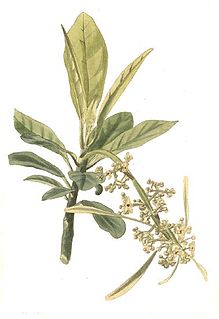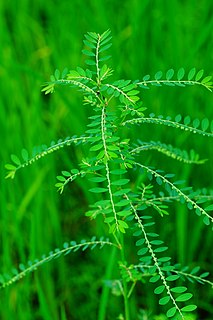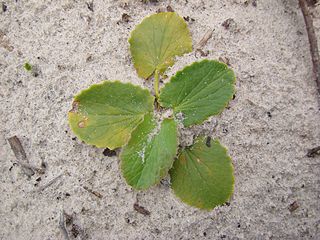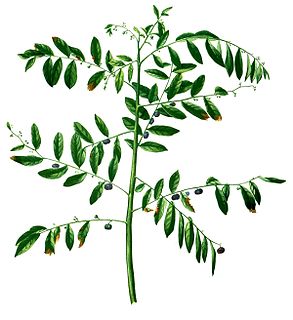Appius Claudius is a combination of first name (praenomen) and family name (nomen) that was traditional in the gens Claudia during the Roman Republic. Appius was a particularly common praenomen for the branch of Claudii who used Pulcher as a cognomen. Men known as Appius Claudius include:

The naval Battle of Drepana took place in 249 BC during the First Punic War near modern Trapani, western Sicily between the fleets of Carthage under Adherbal and the Roman Republic under Publius Claudius Pulcher. The Roman fleet was destroyed with the loss of 93 ships and 8,000–20,000 men in Carthage's greatest naval victory of the war. The Carthaginians exploited their victory by raiding the coasts of Roman Italy in 248. The Romans did not mount a major naval effort until 242 BC.
Claudia Pulchra was the name of several women of Roman gens of Claudii during the 1st century BC and 1st century AD. The Latin pulchra is the root of the English word pulchritude.

Phyllanthaceae is a family of flowering plants in the eudicot order Malpighiales. It is most closely related to the family Picrodendraceae.
Appius Claudius Pulcher was a Roman politician of the 1st century BC. There is uncertainty about who his father was. It was most probably the Appius Claudius Pulcher who was consul in 143 BC. He was a supporter of Lucius Cornelius Sulla and served as praetor in 88 BC. He was exiled in that year by Gaius Marius while Sulla was away in the east. He returned to Rome after Lucius Cornelius Cinna died in 84 BC, and served as consul in 79 BC and as governor of Roman Macedonia from 78 BC to 76 BC.

Phyllanthus emblica, also known as emblic, emblic myrobalan, myrobalan, Indian gooseberry, Malacca tree, or amla from Sanskrit amalaki is a deciduous tree of the family Phyllanthaceae. It has edible fruit, referred to by the same name.

Omphalea is a plant genus of the family Euphorbiaceae first described as a genus in 1759. It is native to tropical parts of the Americas, the West Indies, Asia, Australia, and Africa.

Pelvicachromis pulcher is a freshwater fish of the cichlid family, endemic to Nigeria and Cameroon. The species is popular amongst aquarium hobbyists, and is most commonly sold under the name kribensis, although the species has other common names, including various derivatives and color morphs of the kribensis: krib, common krib, red krib, super-red krib and rainbow krib, along with rainbow cichlid and purple cichlid. The species is a popular cichlid for the aquarium.
Phyllanthus manono, also known as manono or mahame in Tahitian, is a species of small tree in the Phyllanthaceae family. It is endemic to the Windward Society Islands in French Polynesia, where it is found on the islands of Tahiti and Moorea. Compared to other species of Phyllanthus in the Society Islands, P. manono is found in relatively low-elevation areas, including some disturbed environments.
Phyllanthus pavonianus, synonym Phyllanthus haughtii, is a species of plant in the Phyllanthaceae family. It is native from south Ecuador to north-west Peru. Its natural habitat is subtropical or tropical moist montane forests. Under the synonym Phyllanthus haughtii, it has been regarded as "endangered".

Phyllanthus caroliniensis, the Carolina leafflower, is a flowering plant native to the Americas, from the southeastern United States all the way to Argentina. The flowers are small and located where the leaf meets the stem.
There were a number of Romans named Publius Claudius:

Epiphyllum phyllanthus, commonly known as the climbing cactus, is a species of epiphytic cacti. It has no leaves, instead having stems that photosynthesise. It is thought to be pollinated by hawkmoths, as the flowers only open at night and produce a strong fragrance.
Appius Claudius Pulcher was a Roman politician. An early supporter of Augustus, he was elected consul in 38 BC.

Phyllanthus niruri is a widespread tropical plant commonly found in coastal areas, known by the common names gale of the wind, stonebreaker or seed-under-leaf. It is a relative of the spurges, belonging to the genus Phyllanthus of the family Phyllanthaceae.

The Lunsford-Pulcher Archeological Site is a prehistoric archaeological site in rural Monroe and St. Clair counties in Illinois. The site was the location of a Middle Mississippian village which was probably a satellite community of Cahokia. Several pyramidal burial mounds are included in the site. Archaeological excavations at the site have also discovered the remains of houses and garden beds, making the site one of the few Mississippian villages at which garden beds have been found. The site has been known to European settlers since early settlement of the area in the late 18th century; despite being used for farmland, the site remains in good condition.

Ch. Surender Singh Memorial Herbal Park, Tosham is a herbal and medicinal plants park in Tosham town of Bhiwani district in the Indian state of Haryana.

Phyllanthus reticulatus is a plant species described Jean Louis Marie Poiret; it is included in the family Phyllanthaceae.












